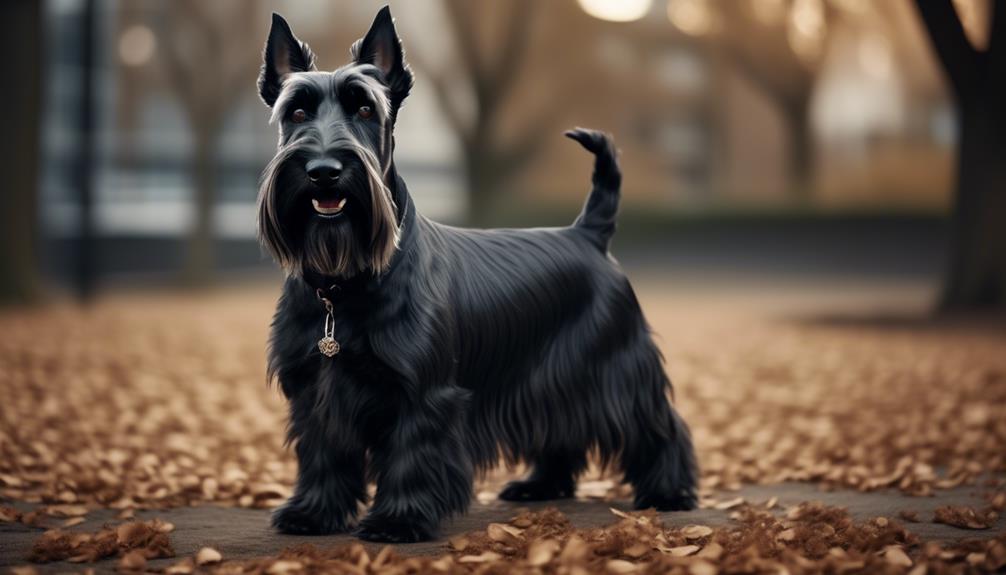
If you’re seeking a dog breed that embodies charm, intelligence, and a touch of regal elegance, look no further than the Scottish Terrier.
With their iconic silhouette and distinctive coat, these small yet mighty canines are sure to capture your attention.
But there’s more to Scottish Terriers than meets the eye. From their independent nature to their loyalty and affection towards their families, there’s a wealth of information and characteristics waiting to be discovered.
So, prepare to embark on a journey of exploration into the world of Scottish Terriers, where you’ll uncover fascinating details about their origin, temperament, exercise needs, and much more.
Key Takeaways
- Scottish Terriers are small terrier dogs with a double coat and come in various colors.
- They have a confident and affectionate temperament but can be reserved around strangers.
- Scottish Terriers require moderate exercise and mental stimulation.
- They adapt well to apartment living but may exhibit high energy and frequent barking.
Origin and Size
Where did the Scottish Terrier originate and how does it compare in size to other breeds?
The Scottish Terrier, also known as the Scottie, originated in Scotland. This small breed falls into the terrier group and has a distinctive appearance with a wiry outer coat and a soft undercoat.
In terms of size, the Scottish Terrier is considered small, typically weighing between 18 and 22 pounds. When compared to other breeds, it’s smaller than medium-sized and large breeds such as Labrador Retrievers or German Shepherds.
Despite their small stature, Scottish Terriers are known for their independent and confident personalities. They’ve a lifespan of 12 to 15 years and make affectionate companions for their families.
See another Dog breed profile.
Sealyham Terrier Dog Breed
Temperament and Training

Scottish Terriers have a serious and reserved personality, but are opinionated, independent, and smart. They can be aloof towards strangers, but are devoted to their families. Sensitivity levels and tolerance for being alone vary among dogs, as does their ability to handle cold and hot weather.
Scottish Terriers are sensitive to praise and anger, and can be slow to accept outsiders. It’s recommended to enroll them in socialization classes to help them become more accepting of new people and situations. They’ve a strong digging instinct and can display aggression towards other dogs if not properly socialized.
Scottish Terriers require daily moderate exercise and mental stimulation to keep them happy and healthy.
Exercise Needs and Health Concerns
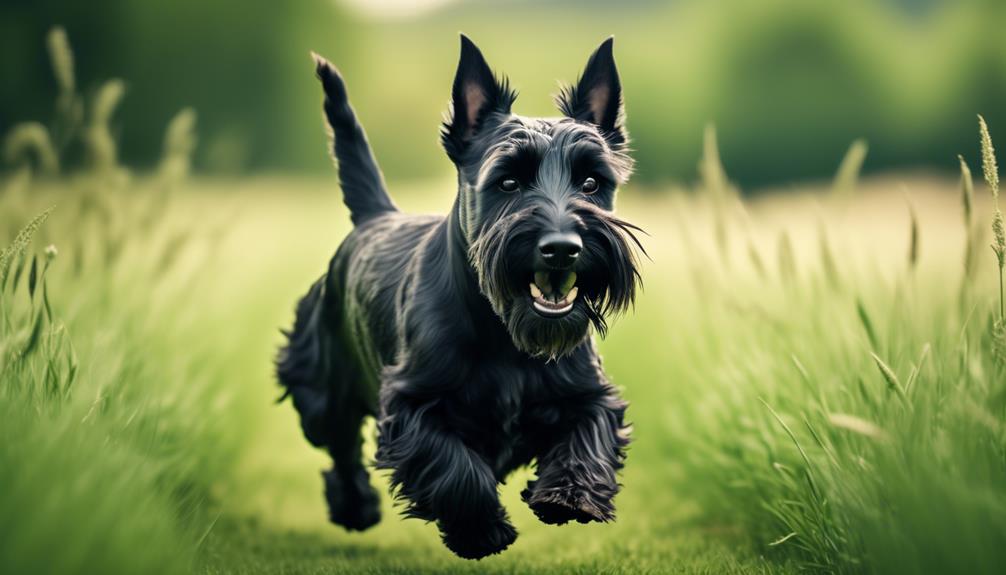
To ensure the well-being of Scottish Terriers, it’s important to address their exercise needs and be aware of potential health concerns.
Scottish Terriers have moderate exercise needs and require daily physical activity to stay healthy. While they aren’t suitable as jogging companions due to their short legs, they still need daily walks and mental stimulation to prevent boredom and destructive behavior.
As for health concerns, Scottish Terriers are prone to von Willebrand’s disease, patellar luxation, and skin allergies. Regular veterinary care, proper nutrition, and a safe living environment are necessary to maintain their overall health.
Apartment Living and Adaptability

Living in an apartment requires careful consideration of a dog’s adaptability and suitability for shared spaces. When it comes to Scottish Terriers, they have certain qualities that make them well-suited for apartment living. Here are some factors to consider:
- Size alone shouldn’t be the sole determinant when choosing a dog for an apartment.
- Consider energy levels and space requirements of different breeds.
- Prioritize qualities such as being quiet, low-energy, calm indoors, and well-mannered.
- Take into account your dog-owning experience when choosing a dog.
Scottish Terriers, with their independent and confident nature, can adapt well to apartment living. However, it’s important to ensure they get enough exercise and mental stimulation to prevent boredom and destructive behavior.
Socialization and Cold Weather Tolerance

When socializing a Scottish Terrier, it is important to expose them to various people, animals, and environments to ensure they develop into well-rounded and confident dogs. Scotties can be reserved around strangers and may display aggression towards other dogs if not properly socialized. Socialization classes are recommended to help them accept outsiders and become more comfortable in new situations. Additionally, Scottish Terriers have a moderate tolerance for cold weather due to their double coat, which provides insulation. However, they are not well-suited for extremely cold climates and may require extra protection such as sweaters or coats during chilly weather. To evoke emotion in the audience, here is a table showcasing the Scottish Terrier’s socialization needs and cold weather tolerance:
| Socialization | Cold Weather Tolerance |
|---|---|
| Exposure to various people, animals, and environments | Moderate tolerance, may need extra protection in extreme cold |
| Socialization classes recommended | Requires insulation provided by double coat |
| Helps accept outsiders and become more comfortable | Not well-suited for extremely cold climates |
| Prevents aggression towards other dogs | Sweaters or coats may be necessary during chilly weather |
Energy Levels and Playfulness
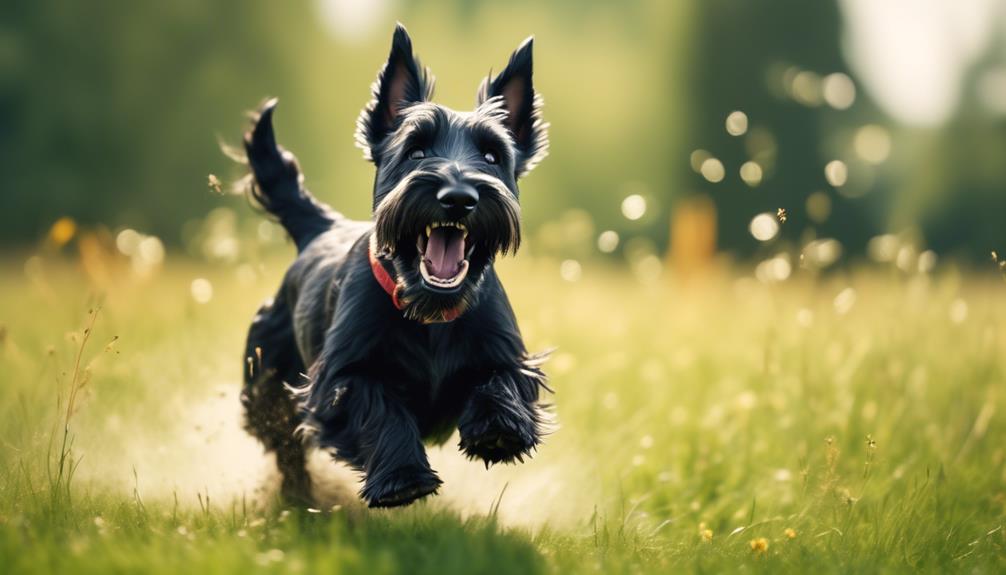
Scottish Terriers have varying energy levels and playfulness. Understanding the energy level and playfulness of a Scottish Terrier is important when considering this breed as a pet. Here are some key points to know about their energy levels and playfulness:
- Some Scottish Terriers have high energy levels and require significant exercise and mental stimulation.
- Others have low energy levels and are more content with a relaxed lifestyle.
Playfulness varies among Scottish Terriers, with some being perpetual puppies and others being more serious and sedate.
It’s important to consider the level of playfulness that matches your lifestyle and the availability of playmates for your dog.
Care and Grooming
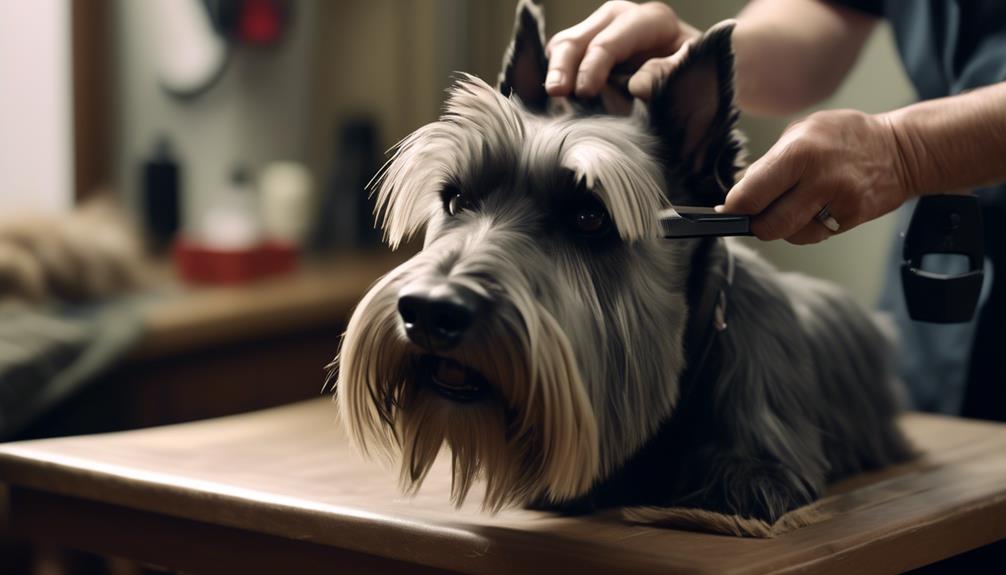
Regular grooming is necessary for Scottish Terriers to maintain the health and appearance of their wiry coats. Their double coat consists of a wiry outer coat and a soft undercoat. To help visualize their grooming needs, here is a table:
| Grooming Needs | Frequency | Description |
|---|---|---|
| Brushing | Weekly | Removes loose hair and prevents matting |
| Combing | Weekly | Helps remove tangles and keeps coat neat |
| Trimming | Every 2 months for short hair or several times a year for long hair | Maintains the desired length and shape |
| Stripping | As needed | Technique used for show dogs to remove dead hair |
| Bathing | Every 6-8 weeks or as needed | Keeps the coat clean and free from dirt and odors |
| Nail Trimming | Monthly | Prevents overgrowth and discomfort |
| Ear Cleaning | Weekly | Reduces the risk of infections |
| Dental Care | Daily | Promotes good oral health |
Adoption and Responsible Breeding
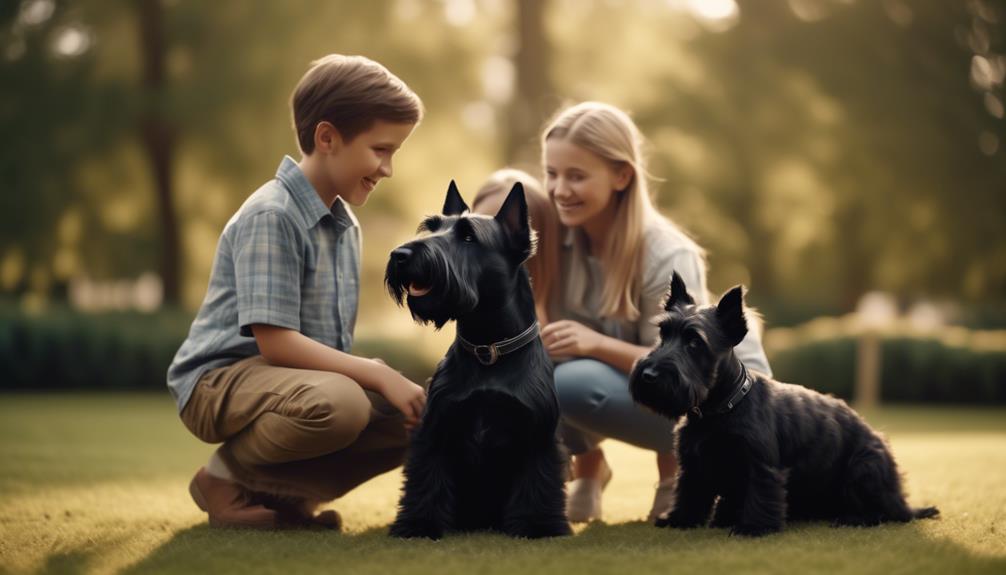
Adoption and responsible breeding play crucial roles in ensuring the well-being and future of Scottish Terriers. It’s important to consider adoption as there are many Scottish Terriers in need of loving homes. Various rescue organizations, such as the Canadian Scottish Terrier Club and Scottie Kingdom Rescue, provide opportunities for adoption and fostering.
Reputable breeders also play a significant role in maintaining the breed’s health and temperament. They screen their breeding stock for health problems and socialize their puppies from a young age.
On the other hand, backyard breeders prioritize profit over the well-being of the dogs, resulting in puppies with potential health and behavioral issues.
Frequently Asked Questions
What Are Some Common Health Issues That Scottish Terriers May Face?
Scottish Terriers may face common health issues such as von Willebrand’s disease, patellar luxation, and skin allergies. Proper nutrition and veterinary care are necessary for their overall health and well-being.
Are Scottish Terriers Good With Children?
Scottish Terriers can be good with well-behaved children, but may not tolerate toddlers or young children. It’s important to set them up for success and avoid situations that trigger their instincts.
Can Scottish Terriers Swim?
Yes, Scottish Terriers cannot swim due to their short legs and heavy body. It is important to keep them leashed near water to ensure their safety.
How Often Should a Scottish Terrier Be Groomed?
A Scottish Terrier should be groomed regularly to maintain their wiry coat. This breed typically needs brushing, combing, and trimming. Show dogs may require a technique called stripping. Grooming should be done every few months or as needed.
Are Scottish Terriers Suitable for Households With Smaller Pets Like Cats or Hamsters?
Scottish Terriers may not be suitable for households with smaller pets like cats or hamsters due to their hunting instincts. They have a strong prey drive and may be prone to chasing or even harming smaller animals.
Conclusion
In conclusion, the Scottish Terrier is a small and independent dog breed with a confident and affectionate temperament. They require moderate exercise and training, and are prone to certain health concerns.
Despite their size, Scottish Terriers can adapt well to apartment living and cold weather. They have moderate energy levels and enjoy playtime.
Proper care and grooming are essential for their well-being. For those interested in welcoming a Scottish Terrier into their home, adoption and responsible breeding options are available.




